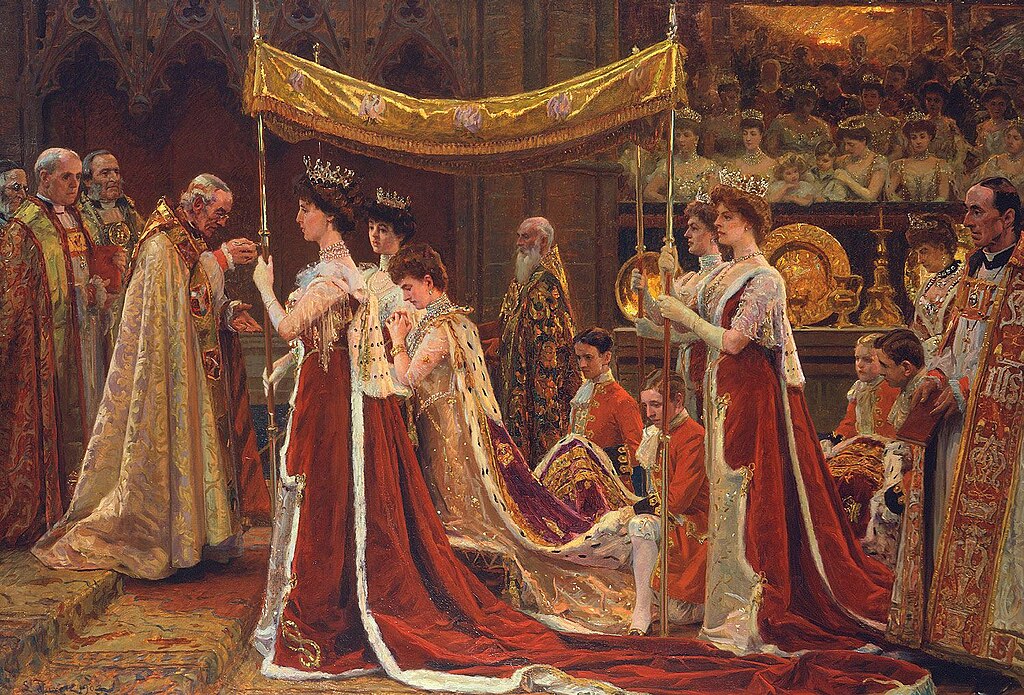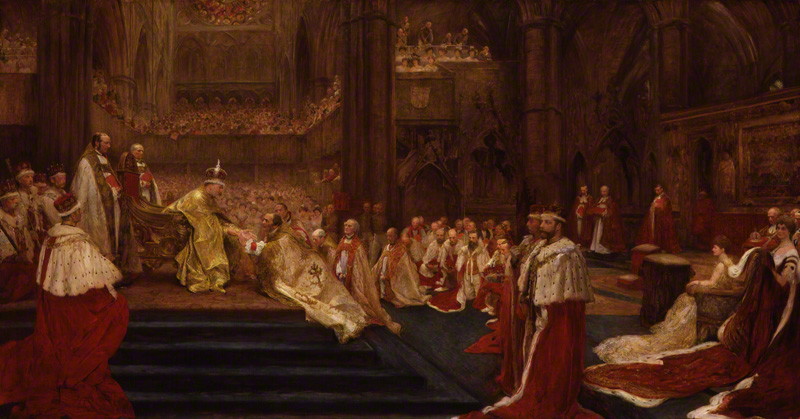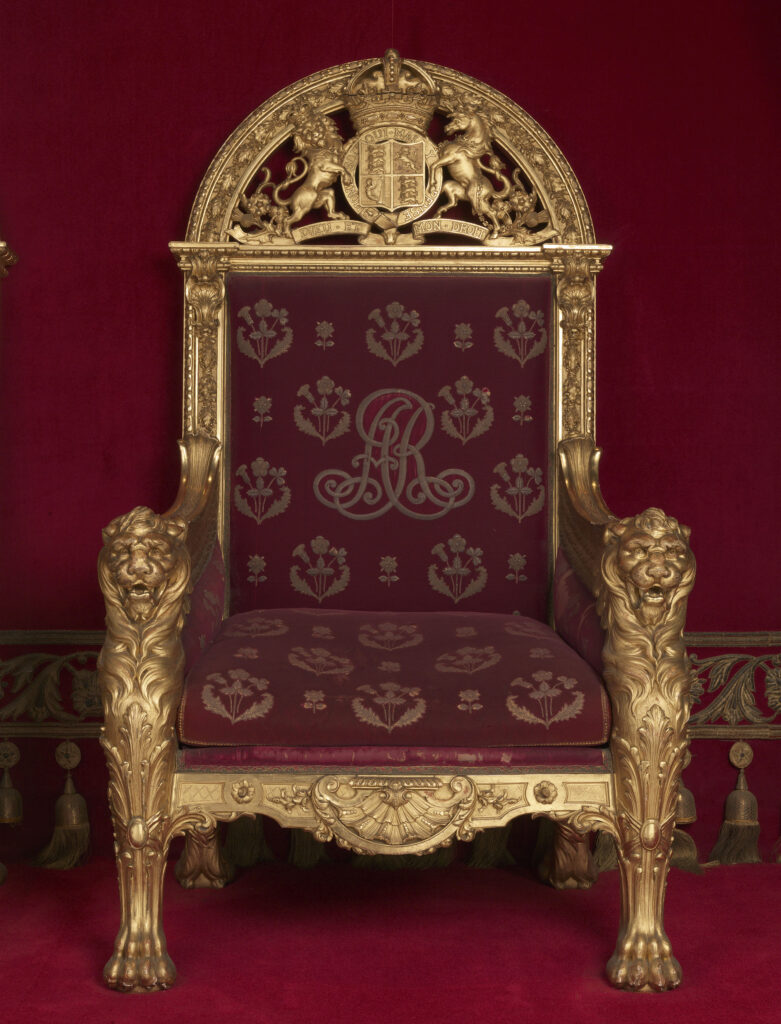
Some of the glittering items used at the Coronation of Edward VII and Queen Alexandra are currently on show in London. Visitors to The King’s Gallery can see the gold mantle worn by the King and the glorious dress used by his consort in the exhibition The Edwardians: Age of Elegance. Yet these historic artefacts almost became more famous as remnants of a Coronation that never was. For after serving as heir to the throne for decades, Edward’s reign almost ended before he was crowned.
King Edward VII’s Coronation took place on August 9th 1902 but that wasn’t the original date for the ceremony. He was due to be crowned on June 26 but was taken seriously ill just days before and had to be treated for appendicitis.
Disaster almost stops a Coronation
Just days before the planned ceremony, disaster struck. On 24 June 1902, King Edward VII was taken seriously ill. Doctors diagnosed him with appendicitis—a condition which, in the early twentieth century, was often fatal due to the lack of antibiotics and modern surgical techniques. The king, then aged sixty, was in grave danger and required immediate surgery.
The royal medical team, led by Sir Frederick Treves, proposed a then relatively new and risky operation: appendectomy. The king’s life hung in the balance, and the medical consensus was that any attempt to proceed with the coronation would be reckless. Edward VII himself, always mindful of duty, was reluctantly persuaded to agree to a postponement.
The announcement sent shockwaves across Britain and beyond. Crowds had already gathered in London, streets adorned with flags and bunting, hotels booked to capacity with foreign guests. The cancellation was unprecedented in living memory. For many, it cast a pall over the celebrations and raised anxieties about the king’s health and the stability of the monarchy.

Public reaction was a mix of disappointment and concern. The press reported widely on the king’s condition, and prayers for his recovery were held in churches around the country. International visitors, faced with uncertainty, either extended their stays or returned home. The logistical challenges were immense: ceremonial troops had to be stood down, processions rescheduled, and thousands of events cancelled or rearranged.
Edward’s successful surgery became a turning point not only for himself but also for the development of abdominal surgery. The king recovered, and the postponement allowed for a wave of public sympathy and admiration. The British people, and many abroad, were united in their support for Edward VII.
Edward came close to death but almost as soon as he came round from life saving surgery, he was making plans for his Coronation again.
A fresh start and huge support for the King who almost died
He chose a date as close to the original as his health would allow and on August 9th 1902, London was treated to a spectacle that saw the Edwardian age begin in earnest. The keenly anticipated coronation of King Edward VII and Queen Alexandra at Westminster Abbey was not merely a ceremony of monarchy, but a herald of a new era. Their accession, following Queen Victoria’s lengthy reign, allowed the duo to reimagine royal pageantry; the event boasted gilded thrones commissioned from Parisian artisans and music worthy of a renaissance, directed by Sir Frederick Bridge.
Queen Alexandra, the Danish princess turned English queen, distinguished herself as a trendsetter. Eschewing the tradition of white or cream coronation robes, she opted for a glittering gold silk gown by Morin Blossier of Paris. Embellished with thousands of tiny gold spangles, the gown was designed to shimmer under Westminster Abbey’s newly installed electric lights—an innovation in itself.

At her request, the dress became the first royal coronation gown to incorporate Britain’s floral emblems—rose, thistle, and shamrock—a symbolic gesture that future queens would echo.
The ceremony itself finally unfurled as a spectacle of imperial might and modern elegance. The Abbey, the procession, the music—all spoke of a nation eager to assert its grandeur in the modern age. Edward VII and Queen Alexandra were crowned in Westminster Abbey in the presence of many dignitaries and representatives from the British Empire and the wider world. The day was marked by celebration and relief, with the king’s survival adding a layer of poignancy to the proceedings.
Glittering relics of a famous Coronation
Fast forward to 2025, and The Edwardians: Age of Elegance exhibition revives that bygone luminescence. More than 300 masterpieces from the Royal Collection are displayed at The King’s Gallery. Visitors are greeted by towering state portraits by Sir Samuel Luke Fildes, monumental in scale and rich in presence, alongside Alexandra’s gown, Edward’s cloth-of-gold mantle, the royal thrones, and intimate treasures such as the Dagmar necklace and her diamond-handled ostrich feather fan.

The gown itself, fragile and rarely seen—its last public display occurred over 30 years ago—is now presented under watchful conservation, following over 100 hours of preparatory work. Curator Kathryn Jones describes how its gold has mellowed with time, yet newspapers of 1902 recall how it seemed to catch flame under the electric lighting, casting the Queen in an “extraordinary blaze of golden light.

Reflecting on that gilded coronation through the prism of 2025, one sees Alexandra’s gold gown not merely as a dress, but as a shimmering manifesto. It stands as a testament to royal boldness, technological progress, and cultural symbolism. The exhibition, running until November, allows the modern visitor to stand literally and figuratively in the glow of her choice—one that sparkled then, and continues to captivate more than a century later.

